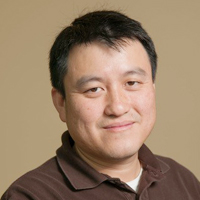Title of Presentation
“Nanophotonics and Its Fusion with Topological Science: Synthetic Gauge Potential for Light”
The mathematics of topology concerns the general property of geometric objects that is independent of continuous change of the size and the shape of the objects. The concepts of topology are now widely used to develop deep insights into the fundamental properties of the states of physical matters. Here a key development is the concept of topological robustness. A physical quantity that is related to the topological properties of the physical states tends to be robust against the fluctuation of the systems. In condensed matter physics, the developments of topological concepts have revolutionized our understanding of many-body electronic systems in the past several decades.
In this talk, we highlight the emerging fusion of photonics with topology. For electrons, a key Scapability for creating non-trivial topological effects is through the use of magnetic field. Photons are neutral particles, and therefore there is no naturally occurring magnetic field that couples to photons. Nevertheless, we show that in photonic systems undergoing refractive index modulation, the phase of the modulation in fact provides a synthetic gauge potential and an effective magnetic field for light that breaks time-reversal symmetry for light. The research effort in this direction may lead to the creation of highly versatile on-chip photonic circuits, with enhanced reconfigurability and robustness for information processing.
Profile
- Web Site URL
- http://web.stanford.edu/~shanhui/
- A brief Biography
-
Shanhui Fan is a Professor of Electrical Engineering, a Professor of Applied Physics (by courtesy), and the Director of the Edward L. Ginzton Laboratory, at the Stanford University. He did his undergraduate study in physics at the University of Science and Technology of China (USTC) from 1988-1992, and received his Ph. D in 1997 in theoretical condensed matter physics from the Massachusetts Institute of Technology (MIT). He was a Postdoctoral Research Associate in the Physics Department and then a Research Scientist in the Research Laboratory of Electronics at MIT, before he joined the faculty of the Stanford University in 2001.
His research interests are in fundamental studies of solid state and photonic structures and devices, especially photonic crystals, plasmonics, and meta-materials, and applications of these structures in energy and information technology applications. He has published 400 refereed journal articles that were cited over 48,000 times according to Google Scholar, has given over 300 plenary/keynote/invited talks, and holds 60 granted US patents. Based on his research he has also co-founded two startups aiming to commercialize the technology of radiative cooling, and cloud-based high-throughput scientific computing.
- Details of selected Awards and Honors
-
Vannevar Bush Faculty Fellowship from the U. S. Department of Defense, 2017.
Thomson Reuters Highly Cited Researcher in Physics, 2015, 2016.
Fellow, the IEEE, elected 2010.
Citation: “for contributions to nanophotonics”.
Fellow, the SPIE, elected 2009.
Fellow, the American Physical Society (APS), elected 2008.
Citation: “For contributions to the theory and applications of nanophotonic structures and devices, including photonic crystals, plasmonics and meta-materials”.
Fellow, the Optical Society of America (OSA), elected 2007.
Citation: “For many deep and creative contributions to physics, analysis, and novel devices in semiconductor, dielectric and metallic optical nanostructures”,
The Adolph Lomb Medal, Optical Society of America, 2007.
Citation: “For fundamental work in nano-photonic structures”.
The National Academy of Sciences William O. Baker Award, 2007.
Citation: “For innovative research on the theory and applications of photonic crystal devices”.
David and Lucile Packard Fellowship in Science and Engineering, 2003.
National Science Foundation Career Award, 2002.
- A list of selected Publications
-
S. Assawaworrarit, X. Yu and S. Fan, “Robust wireless power transfer using a nonlinear parity-time symmetric circuit”, Nature (under revision, 2017).
Q. Lin, M. Xiao, L. Yuan and S. Fan, “Photonic Weyl point in a two-dimensional resonator lattice with a synthetic frequency dimension”, Nature Communications, vol. 7, art. No. 13731 (2016).
P. Hsu, A. Song, P. Catrysse, C. Liu, Y. Peng, J. Xie, S. Fan and Y. Cui, “Radiative human body cooling by nanoporous polyethylene textile”, Science, vol. 353, pp. 1019-1023 (2016).
Y. Shi, Z. Yu and S. Fan, “Limitations of nonlinear optical isolators due to dynamic reciprocity”, Nature Photonics, vol. 9, pp. 388-392 (2015).
A. P. Raman, M. A. Anoma, L. Zhu, E. Rephaeli, and S. Fan, “Passive radiative cooling below ambient air temperature under direct sunlight”, Nature, vol. 515, pp. 540-544 (2014).
L. Tzuang, K. Fang, P. Nussenzveig, S. Fan, and M. Lipson, “Non-reciprocal phase shift induced by an effective magnetic flux for light”, Nature Photonics, vol. 8, pp. 701-705 (2014).
K. Fang, Z. Yu and S. Fan, “Realizing effective magnetic field for photons by controlling the phase of dynamic modulation”, Nature Photonics, vol. 6, pp. 782-787 (2012).
K. Fang, Z. Yu and S. Fan, “Photonic Aharonov-Bohm effect based on dynamic modulation”, Physical Review Letters, vol. 108, art. No. 103901 (2012).
S. Fan, R. Baets, A. Petrov, Z. Yu, J. D. Joannopuolos, W. Freude, A. Melloni, M. Popovic, M. Vanwolleghem, D. Jalas, M. Eich, M. Krausse, H. Renner, E. Brinkmeyer, C. R. Doerr, “Comment on ‘Nonreciprocal light propagation in a silicon photonic circuit’, by Feng et al Science 333, 729, 2011”, Science, vol. 335, p. 38 (2012).
Z. Yu and S. Fan, “Complete optical isolation created by indirect interband photonic transitions”, Nature Photonics, vol. 3, pp. 91-94 (2009).






